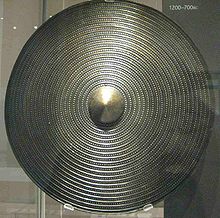Imagine running across a field. You’re tired and out of breath. You’ve been in what seems like an endless game. From sun up to sundown you’re running and fighting to make a goal. To some, it may seem like a game, but not to you. To you, it’s part of your culture, your religion, and, to you, the outcome matters.
Lacrosse was first played by Native American tribes in different regions of North America. There were many different versions of the game, rules, numbers of players, and sizes of the fields that would change depending on the tribe. Names of the game also varied, and included Creators’ Game, Baggataway, and Tewaaraton, which translates to “little brother of war.”1

The name that we know today as lacrosse came about in 1636 when French Missionary Jean de Brebeuf compared the shape of the sticks used by players of the game to a bishop’s crozier, which is ‘‘crosse’’ in French.2
For many Native American tribes, lacrosse wasn’t just a sport, but rather part of their culture and their religion. Since the game was very rough and people could be injured and even die while playing, the Iroquois used lacrosse as a way of training young men to be warriors, and the game was used to settle disputes without actually going to war. This is why lacrosse is nicknamed “little brother of war.”3 Lacrosse also had religious significance among some tribes. It was called the Creator’s Game, and it helped the players put their lives into perspective and teach lessons, some of the most valuable lessons being that everyone has struggles and opponents and the key to survival is friends and allies.
In the culture of the Iroquois, when a man dies, his lacrosse stick is buried with him. They believed that the first thing he would do when he wakes up in the afterlife is to take the stick from his coffin and begin playing that day.4

Native American lacrosse was often played on a stretch of land up to two miles long with sticks between 3-5 feet long made of wood and animal skin. A game could include between one-hundred to one-thousand players at a time. There was no set time to the games. The two teams would agree on a set amount of points and would play from sunrise to sunset until the amount of points was achieved.5 Violence and injuries were very common, and players would often walk away with minor cuts, broken bones, head injuries, and occasionally a death would occur.
Few people can claim to have experienced a Native American game of Lacrosse. Artist George Catlin had a passion for learning about Native Americans, and how they lived. He once said that “If my life is spared, nothing shall stop me short of visiting every nation of Indians on the Continent of North America.” He attended a major Choctaw lacrosse game in 1834. In his time there, he recorded everything that he saw and described how the game was set up from the length of the field and deciding where the goals would be places, to how each team was set up. He described how the night before the match both teams danced and chanted all night. Each team had a medicine man who chanted incantations to strengthen their team and weaken the other. He recorded his experiences through paintings and writings.6
Lacrosse is a sport that has a beautiful history and carries a meaning that many of us will never be able to understand. To Native Americans, lacrosse was a sport, a teaching tool, a religion, and a way to connect their cultures with other tribes.7 Today the history and meaning behind lacrosse has been lost, and to many it has become just another sport played for recreation and friendly competition.
- The Gale Encyclopedia of Fitness, 2012, s.v. ‘”Lacrosse,” by David E. Newton. ↵
- Salem Press Encyclopedia, 2017, s.v., “Lacrosse,” by Justin D. Garcia. ↵
- Thomas Vennum Jr., “American Indian Lacrosse: Little Brother of War,” The Journal of American Folklore 108, No. 427 (1995): 98-99. ↵
- S. L. Price, “Pride of a Nation,” Sports Illustrated 113, no. 2 (2010): 60-71. ↵
- Stanley A. Freed, “Lacrosse yesterday and today,” Cobblestone 15, no.9 (1994): 32. ↵
- Joanna Shaw-Eagle, “Catlin saves vanishing Indians on canvas,” The Washington Times, January 4, 2003. ↵
- John Seabrook, “Gathering of the Tribes,” New Yorker 74, No. 26, (August 1998): 30. ↵



154 comments
Marco Picardo
Very informative and well written article. Upon reading this article I had no idea that it was actually Native Americans who had created the sport of Lacrosse. I’m surprised at the sheer number of players that played in these games, some 100 to 1,000. It was interesting to learn that Lacrosse served multiple purposes for Native Americans, such as religious purposes, and being a tool for teaching.
Alexis Soto
As a huge sports fan, thank you for writing about Lacrosse. I have heard of lacrosse before, but I knew little of its origins. I had no idea it was a Native American sport that was played for different reasons compared to its current modern incarnation. I also found it interesting how the game varied tribe to tribe and how it was more than just sport to them.
Andrew Rodriguez
This article was very interesting in the topic. I had no idea of the origins of lacrosse, and the significance that it meant for the native Americans. The culture of the game has been stripped from the meaning of the sport. It has lost the roots of the game. Instead of going to war they played a game which sounds crazy now. But instead of shedding blood they found a peaceful way to settle disputes between tribes. This article kept my attention the whole time reading it, it was very well written and put together.
Tara Sellers
I never knew the history behind lacrosse. I wonder how it transitioned to the lacrosse we know today. It would be interesting to see one of there games. It could give us an insight into Native American culture. The article says that they would play games instead of going to war sometimes. I find it fascinating that tribes would play against each other.
Mariah Cavanaugh
Your article was not only well written but also very informative. I am not a big sports fan but have heard of the game Lacrosse. I don’t know much about it beyond the name. Your story shows the dark side of cultural appropriation. The game of Lacrosse has a history rooted in religion and culture. I was unaware of this history and saw it as merely a sport. Your article highlights the importance of continuing to educate yourself in regards to history and those that came before us.
Michael Mandujano
This article was well put together, and the featured image influenced my interest in reading “The Creator’s Game.” I enjoyed how the author provided background information on the establishment of Lacrosse, and how the rules have changed overtime. I bet the traditional “Creator’s Game,” was intense and fun to play, because the games allowed one-hundred to one-thousand players to participate. However, the only negative aspect of the Creator’s Game is that there was a high chance of death and severe injuries.
Manuel Aguilera
I have always been very interested in many sports but one I never played was lacrosse, since it was never really popular in the area I lived in and because of my small stature. I feel that the meaning of all sports has been diluted down to just pure competition and no more familial meaning to it. Granted people do in fact grow up with these sports, especially the athletes themselves, but the game has more to do with winning now than just learning.
Valeria Hernandez
I enjoyed reading Zeresh Haman because I have always had some sort of interest in the Native American Culture. It was fascinating to learn that a sport like lacrosse is rooted from the Native American culture. The background information provided by Harman is helpful because It allows the reader to picture the manners and traditions of Indigenous people. A wonderful cultural article.
Thomas Fraire
I have grown up watching Notre Dame Lacrosse since I was young. This article was really well written and I really enjoyed it. It was wild how people used to die playing this sport though. But its awesome how they used Lacrosse as a way to train there young warriors to become men and protect the tribe that they are apart of.
Samman Tyata
Wow! An extremely well-managed article. The content was completely new for me; therefore, i got the chance to learn many things through your article. Furthermore, i really love the pictures that you have used. It is amazing how lacrosse was a sport, a teaching tool, a religion, and a way to connect their cultures with other tribes to Native Americans. Moreover, it was interesting to read that Iroquois used lacrosse as a way of training young men to be warriors, to settle disputes without actually going to war. To sum it up, it was an interesting read.